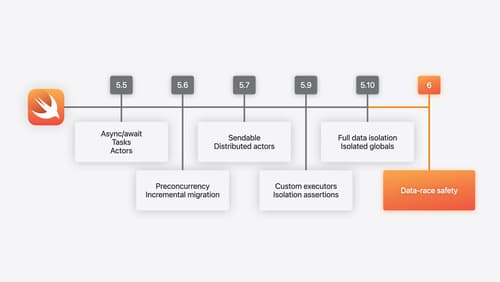swift state
Asked on 2024-09-06
1 search
At WWDC 2024, Apple introduced several updates related to the concept of "state" across different sessions. Here's a summary of the relevant content:
-
Core ML and Stateful Models:
- In the session Bring your machine learning and AI models to Apple silicon, Core ML introduced support for stateful models. This allows models to maintain state across different runs, which can be particularly useful for tasks that require memory of past inputs, such as accumulators. This feature automates the updating of state tensors, improving performance by eliminating the need to define them as inputs or outputs.
-
SwiftUI and State Management:
- In the session SwiftUI essentials, SwiftUI's state management was discussed. SwiftUI uses state to manage the internal data of a view, allowing for dynamic updates. A binding creates a two-way reference to the state of another view, enabling interactive UI components that respond to user input by updating the state and reflecting changes in the UI.
-
Swift 6 and Data-Race Safety:
- The session Migrate your app to Swift 6 highlighted improvements in data-race safety with the introduction of the Swift 6 language mode. This mode enforces data isolation, preventing accidental sharing of state between tasks and actors, which helps in reducing concurrency bugs and improving app stability.
These updates reflect Apple's focus on enhancing performance, safety, and ease of use in app development through improved state management and concurrency handling.

SwiftUI essentials
Join us on a tour of SwiftUI, Apple’s declarative user interface framework. Learn essential concepts for building apps in SwiftUI, like views, state variables, and layout. Discover the breadth of APIs for building fully featured experiences and crafting unique custom components. Whether you’re brand new to SwiftUI or an experienced developer, you’ll learn how to take advantage of what SwiftUI has to offer when building great apps.

What’s new in Swift
Join us for an update on Swift. We’ll briefly go through a history of Swift over the past decade, and show you how the community has grown through workgroups, expanded the package ecosystem, and increased platform support. We’ll introduce you to a new language mode that achieves data-race safety by default, and a language subset that lets you run Swift on highly constrained systems. We’ll also explore some language updates including noncopyable types, typed throws, and improved C++ interoperability.

Bring your machine learning and AI models to Apple silicon
Learn how to optimize your machine learning and AI models to leverage the power of Apple silicon. Review model conversion workflows to prepare your models for on-device deployment. Understand model compression techniques that are compatible with Apple silicon, and at what stages in your model deployment workflow you can apply them. We’ll also explore the tradeoffs between storage size, latency, power usage and accuracy.
